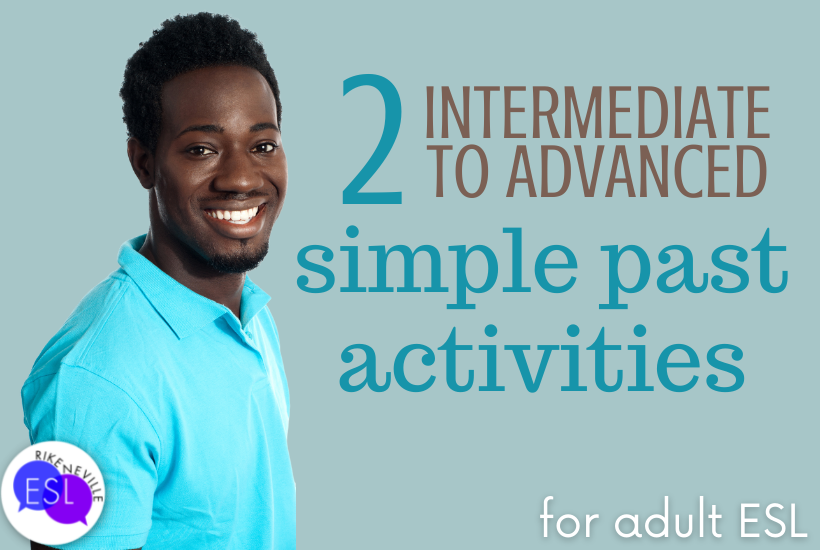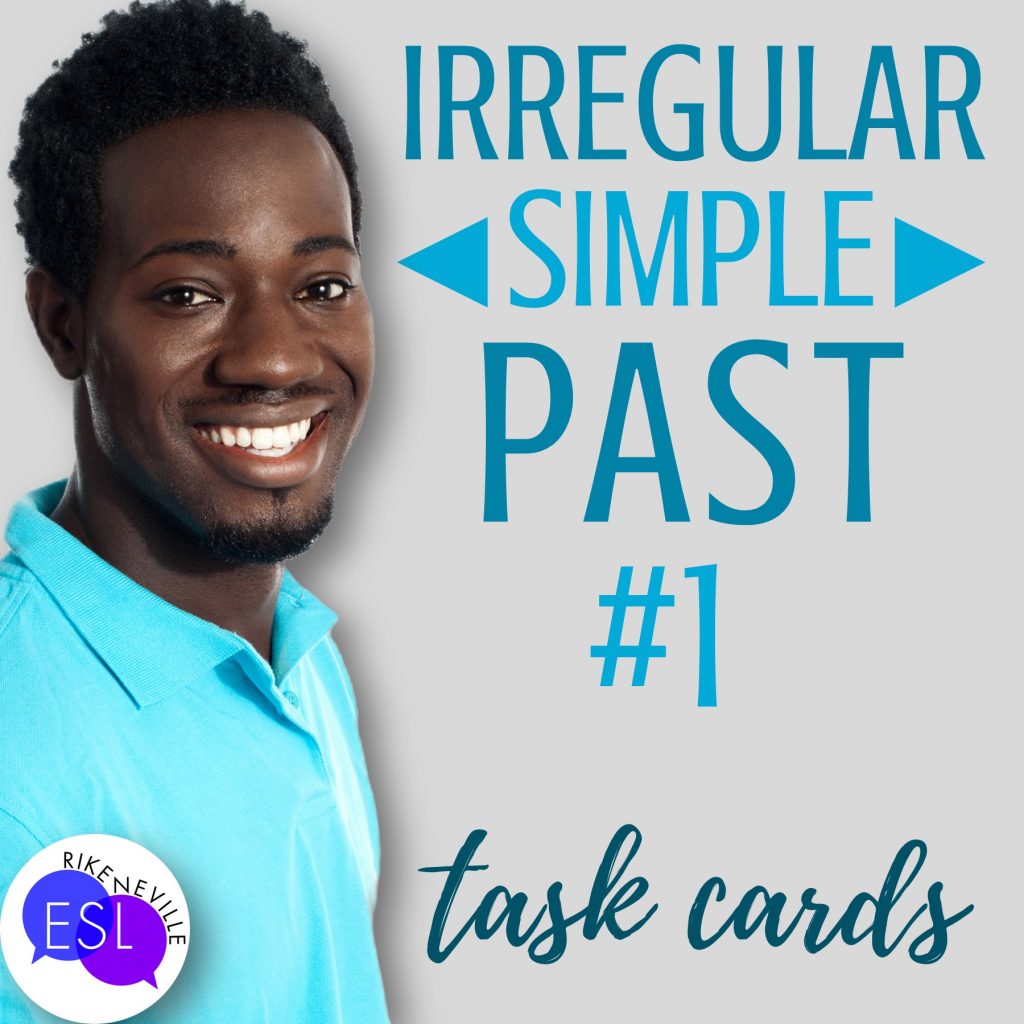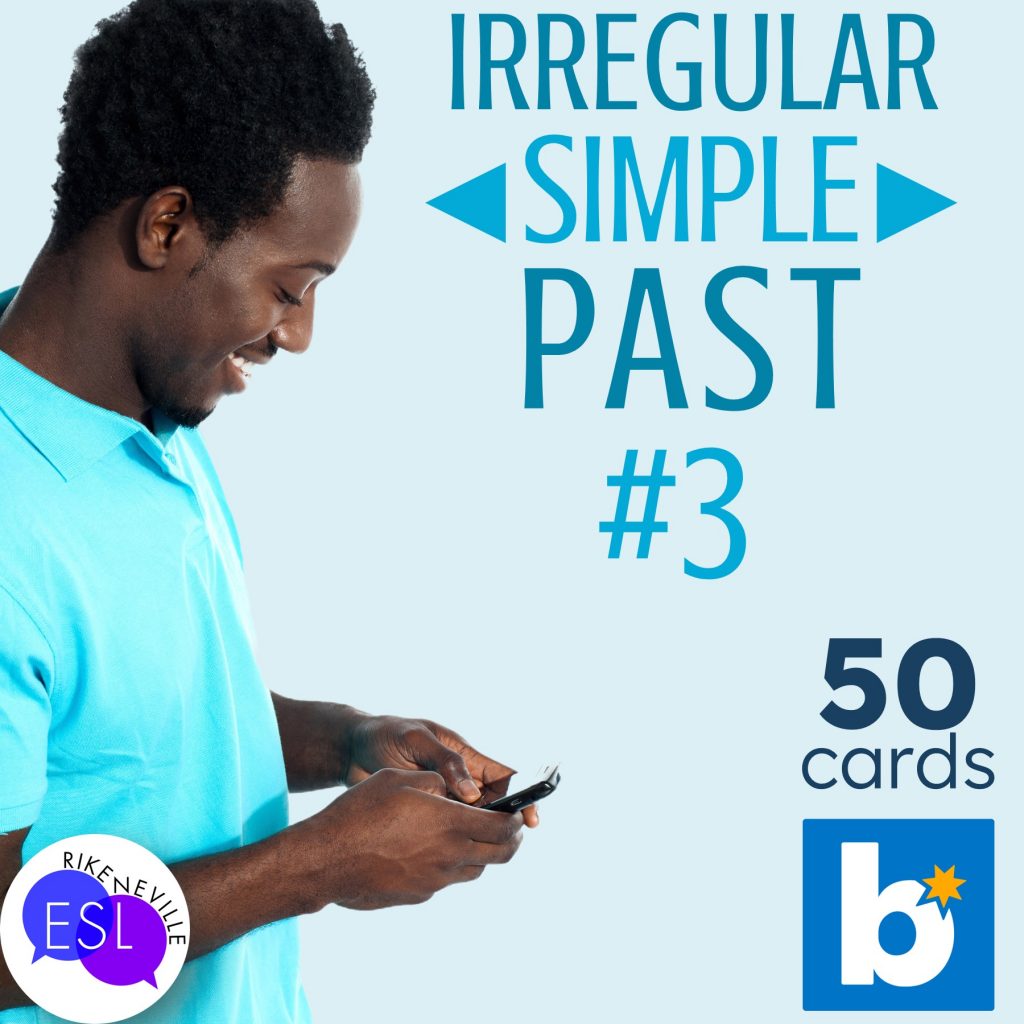Try these four fun simple past activities with your adult ESL students!

Whether you are just starting out with regular verbs or have already started on irregular verbs, you’ll find a fun activity for your adult ESL students here. Sure, many of our adult students like the comfort and familiarity of worksheets, but most also love activities that energize their brains and give them a chance to talk or move about. I want to share four fun simple past activities with you to use with your adult ESL students that you will enjoy along with them!
2 Simple Past Activities for Beginners
Find Someone Who
focus: yes/no Q&A, speaking & listening
This versatile activity can be used over and over again by tweaking it to meet pretty much any grammar concept (but it isn’t limited to grammar class!).
Create a table on a page. This can be any size you like. The more boxes you include, the more speaking your students will have to do. In each box, write the ending for the sentence “Find someone who…” Come up with items that would make good yes/no questions. For example:

The design is simple, and it will not take much time to create your own.
- brushed their teeth last night
- didn’t eat breakfast this morning
- gave someone a ride to class or work last week
You can create it using only regular verbs, only irregular verbs, or a mix.
Then, students would mix among their classmates while using the prompts to ask yes/no questions to get an answer that makes the question describe the person answering the question. Here are some examples:
- Student A: “Did you brush your teeth last night?”
- Student B: “Yes, I did. I brushed my teeth last night.”
In the above scenario, Student A would write Student B’s name in the box and move on to the next question. Whenever there were enough students to do so, I would limit how many times the same student’s name could appear on the table. This ensures that each student asks many different students rather than just the same few.
- Student A: “Did you eat breakfast this morning?”
- Student B: “Yes, I did.”
In this scenario, Student A would then move on to another person (or another question) because the goal is to find someone who did NOT eat breakfast.
- Student A: “Did you give someone a ride to class or work last week?”
- Student B: “No, I didn’t. I didn’t give anyone a ride to class or work last week.”
Here, Student A would still move on to another person (or another question) because the goal is to find someone who DID give someone a ride.
To make this game more accessible, put the exact questions students need to ask in the table’s boxes instead of an ending for “Find someone who…”

Swat It!
focus: positive/negative constructions, listening/reading
You’ll need some new (clean) fly swatters for this activity. Get them in bright colors that contrast if possible.
Suppose you have a deck of cards with verbs in the past tense…woo-hoo~! If not, you might want to buy some or better yet, make some. You COULD also write verbs on the whiteboard, but the fly swatters will make those words harder and hard to read as students play the game.
Divide the class into teams once your board is covered in past tense verbs. One person from each team steps to the board and receives a word (fly) swatter. Call out a verb in the base form, and whoever swats the simple past form of that verb first wins one point. Be sure to instruct students to keep their word swatter on the word they’ve swatted. This makes seeing who was first easier as it will be the swatter on the bottom.
You may also have to make up rules as you go along, depending on the competitiveness of your students. Some of mine in the past have included:
- You can’t use your swatter or your other hand to block someone from swatting.
- You can’t pull someone’s swatter off of a word.
- Do not physically remove someone from the vicinity of the board. (Yep, I had a big, burly student pick up and set to one side a much smaller student.)
If students who are waiting for their turn try to help their teammates by shouting out the answer, remind them that they’ve just given the answer to their competitors’ representatives.
WARNING: Check with anyone teaching in a classroom on the other side of that wall to ensure you aren’t playing this game while their students are taking a test or something like that.
Alternative: Instead of calling out the base form of a verb, say a sentence and HMMMMM where a simple past verb should be. Students then must decide which simple past verb best completes that sentence and swat it.
2 Intermediate to Advanced Simple Past Activities

You will invariably teach non-beginner classes that have students who need a review of lower-level material. The following simple past activities work really well for such students. You can also use these simple past activities as an informal assessment to pinpoint just what part of the simple past they struggle with.
First World Problems (or, Rich People Problems)
focus: yes/no Q&A, speaking & listening
Have students brainstorm a list of the most ridiculous 1st world problems. Have students ask their partners whether or not they suffered from a first-world problem yesterday, last week, last month, or last year.
Optional: If students are not comfortable or unable to create questions at the spur of the moment, have them first transform the list of problems into yes/no questions.
EXAMPLES:

- A: I tried to buy my favorite shampoo brand yesterday, but the store was out.
- B: How dreadful! Did you buy a different brand?
- A: No, I didn’t buy a different brand. I bought nothing. The store only had ten other brands. The selection was awful.
- B: Did you go to another store?
- A: Yes, I did. I went to another store. Thankfully, they had my shampoo brand. However, they didn’t have the scent I wanted.
- A: I bought a brand new 5g phone yesterday. Then I found out that I could only get 4g at my mansion.
- B: That’s terrible! Such a weak signal! Did you return the phone?
- A: No, I didn’t return the phone. I threw it away.
- B: Did you call anyone to find out if 5g is coming to your area soon?
- C: No, I didn’t call anyone. I put my mansion up for sale. I need to live in a better location.
Alternative: To use this simple past activity with a lower-level class, write conversations with gaps replacing the verbs. Have students fill in the gaps as they read.
A Pollyanna Day, aka The Day of Silver Linings
focus: positive and negative sentence construction, speaking & listening
Have students brainstorm a list of the seemingly bad things that could happen for which they can also come up with a bright side. Then, have them work together in pairs to create a conversation where two speakers share what their day was like yesterday, attempt to commiserate, and then find the silver lining.
Optional: If this is a simple past review for higher-level students, make this a speaking exercise instead. Once they have their list, have them role-play a conversation of misfortunes and silver linings.
Example:
- A: Yesterday, my car didn’t start. I stubbed my toe on my way to my neighbor’s house. Then I stepped in dog poo.
- B: Oh, no! How awful! It sounds like you had a terrible day.
- A: It wasn’t so bad. My neighbor gave my car a jump. My toe didn’t hurt very much, and the dog poo didn’t smell at all!
Interested in some printable and digital simple past activities, worksheets, and more?
You’ll find lots of simple past resources in my TpT store and in my BOOM store. Here is a taste:







Leave a Reply